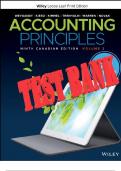Other
TEST BANK for Accounting Principles, Volume 2, 9th Canadian Edition by Jerry J. Weygandt, Donald E. Kieso and Paul D. Kimmel ISBN-.
- Course
- Institution
- Book
TEST BANK for Accounting Principles, Volume 2, 9th Canadian Edition by Jerry J. Weygandt, Donald E. Kieso and Paul D. Kimmel ISBN-.
[Show more]



